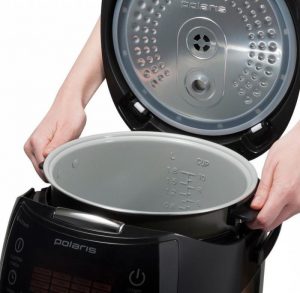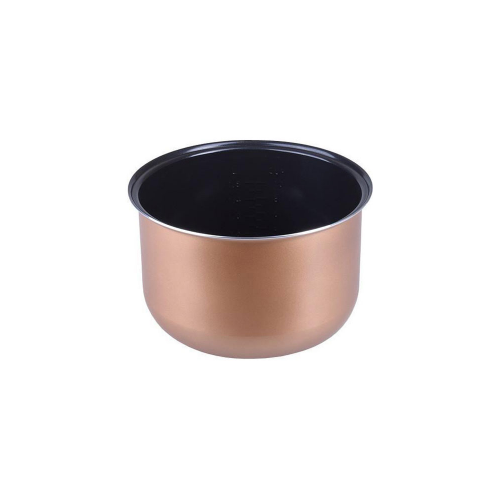 What types of material used in creating the bowl of a multifunctional gadget are the most popular among manufacturers today? What are the fundamental differences between them and do they really have weight? And also about what advantages and disadvantages of a bowl of multicookers of various types should a potential buyer know in order not to regret their choice in the future? The following article contains detailed answers to these questions, knowing which it will be easier for the user to determine the model of the device, designed to greatly facilitate the daily cooking process.
What types of material used in creating the bowl of a multifunctional gadget are the most popular among manufacturers today? What are the fundamental differences between them and do they really have weight? And also about what advantages and disadvantages of a bowl of multicookers of various types should a potential buyer know in order not to regret their choice in the future? The following article contains detailed answers to these questions, knowing which it will be easier for the user to determine the model of the device, designed to greatly facilitate the daily cooking process.
Types of Coatings
The modern market for household appliances is “full of” a variety of model lines of multicookers with non-stick coating. Most buyers evaluate, as a rule, the material of the “backbone” of the housing of the household gadget, choosing between a metal or plastic structure. Few potential owners of an advanced device are aware or pay due attention when analyzing the available assortment to the material of the directly functional bowl of the “automated assistant”. But in vain, because it is this indicator that has a huge impact on the quality of food cooked in the appliance, the safety of the resulting dish for human health, the likely durability of the multicooker and the convenience of washing it when the “cooking” process is completed.
The most popular today in view of the optimal price-quality ratio for both the buyer and the manufacturer are Teflon and ceramic bowls. Both Teflon and ceramics cannot be called ideal options for coating the functional element of the multicooker. To formulate our own assessment of the importance of the negative aspects of each type in comparison with the positive ones, we propose to consider in detail the features of each of them.
First of all, it is worth emphasizing the relative novelty of the idea of using ceramics as a bowl coating for the considered household appliances (no more than 8-10 years), despite the knowledge about the properties of this material back in the 40s of the last century.
The main advantage of the ceramic bowl of the multicooker is its environmental friendliness. In an age of poor ecology, the widespread use of genetically modified products, the manufacturer’s statement about the absolute safety of the proposed product certainly deserves the attention of consumers. Ecological “purity” of ceramics is achieved through its production on a water basis, which eliminates the ingress of harmful impurities into the prepared dishes contained in the “industrial” case material and functional capacity even at high temperatures, as well as imparting a “chemical flavor” to the products.
An equally important positive characteristic of a ceramic coating is the simplicity of its maintenance in comparison with a Teflon analog. So, having finished cooking, it will be enough to rinse the bowl with detergent and a soft sponge without first “soaking”.
The next distinctive feature of the considered type of coating of the multicooker, characterizing it from the best side, should be called heat resistance. Withstanding temperatures up to 450 degrees Celsius without deformation, the ceramic bowl can easily be used in the most preheated oven.
Also, being the base material in the manufacture of the functional capacity of the multicooker, ceramics will provide such a gadget with the best non-stick properties. It is worth emphasizing their importance for organizing a comfortable cooking process, especially healthy food or dishes for young children.
However, the seemingly ideal ceramic coating of the bowl of a multifunctional gadget has a number of drawbacks that have their own importance in forming an objective assessment of its quality.
So, among the main negative aspects of using devices made of the material in question, one can name low wear resistance. Despite the use by manufacturers of special production technologies that can “extend the life” of ceramics, with the regular use of such a gadget, the need to replace the functional bowl will arise about 1.5 to 2 years after purchase.
Ceramic coating should be protected from contact with alkali, as a result of which its destruction can occur literally before your eyes in a matter of minutes. This feature will cause significant inconvenience to users who are accustomed to resorting to the help of dishwashers. In such a situation, the owner of a ceramic multicooker will have to carefully select detergents, each time making sure that there is no alkaline element in their composition.
Given the significant advantages of ceramics listed above, the high cost of multicookers with such a bowl will not be surprising, which can also be attributed to the features of the device in question, delivering not the most pleasant emotions from its use.

When analyzing a Teflon coating, it is worthwhile, first of all, among its advantages to note high-class non-stick characteristics that significantly exceed in their degree the similar properties of a ceramic coating.
If, when using a ceramic bowl, the owner of the multicooker is forced to carefully select detergents, then the Teflon container is “unpretentious” in care. It is highly resistant to chemical attack and, accordingly, can be “rinsed” without problems after “cooking” even in a dishwasher.
A relatively good indicator of heat resistance also deserves special attention and mention among the positive characteristics of the Teflon bowl of a household gadget. It is able to withstand up to 260 degrees without deformation. This temperature is lower than the maximum similar ceramic coating capability, but objectively greater than a traditional pan or pan.
Among the disadvantages of the Teflon coating is, first of all, to highlight its ability to emit harmful chemicals under the condition of "pumping" the temperature above the maximum specified. This property, although in practice is quite rare, but the mere realization of such a probability will certainly bring a lot of negative thoughts and feelings to the owner of a multicooker with a functional element from the material in question.
An equally important feature of the far from positive color is the instability of Teflon to the slightest mechanical damage. A primitive careless touch of such a coating with a spoon or a metal spatula is likely to “spill over” into the appearance of scratches on it, affecting the further functional properties of the multicooker as a whole.

How to choose
So, having formulated the main advantages and disadvantages of the Teflon and ceramic coatings in a multicooker, you can make an objective conclusion about which one is better. To simplify the selection of the most suitable model, we suggest the user to familiarize themselves with the following algorithm of actions in deciding to purchase a particular gadget.
First of all, it is advisable for a potential buyer to determine the main criteria that are considered fundamental in his particular case. Among such "prism prisms" should be:
- resistance to external mechanical damage or durability of the bowl coating (Teflon is more durable, ceramics are much more resistant to external mechanical damage);
- ease of operation and maintenance (approximately the same level, but due to the need for careful maintenance of the Teflon coating, eliminating the slightest mechanical impact, the ceramic bowl is in a better position from the point of view of this indicator);
- safety for the health of a person who consumes food prepared in a previously selected multicooker (ceramics are 100% environmentally friendly under any conditions, unlike Teflon, which releases chemicals when the maximum “temperature limit” specified by the manufacturer is exceeded);
- reasonable cost (ceramic coating in most cases has a significantly higher cost compared to the Teflon analog).
By prioritizing the above criteria for evaluating the analyzed household “assistant,” a potential buyer will be able to objectively determine a crock-pot with a coating that maximally satisfies its requirements. So, with a limited budget and a “bet on the duration of operation”, it will be rational to give preference to Teflon coating. And for those who are willing to pay for the preservation of the useful properties of the products used in cooking in the “automated assistant” and resistance to mechanical influences “from the outside”, it is logical to pay attention to multicookers with a modern ceramic coating.
So, based on the information given in the article, both ceramics and teflon have a number of positive and negative aspects of their use. Only after a thorough study of them, as well as an analysis of the criteria for choosing a product according to the degree of importance for the buyer himself, can we conclude that one material is superior to another in this context.
my first slow cooker was a teflon, horror! Now the pottery is a bowl and a frying pan, I have a lifting ten with Redmond Masterfrey. I don’t know any problems with cooking or leaving.